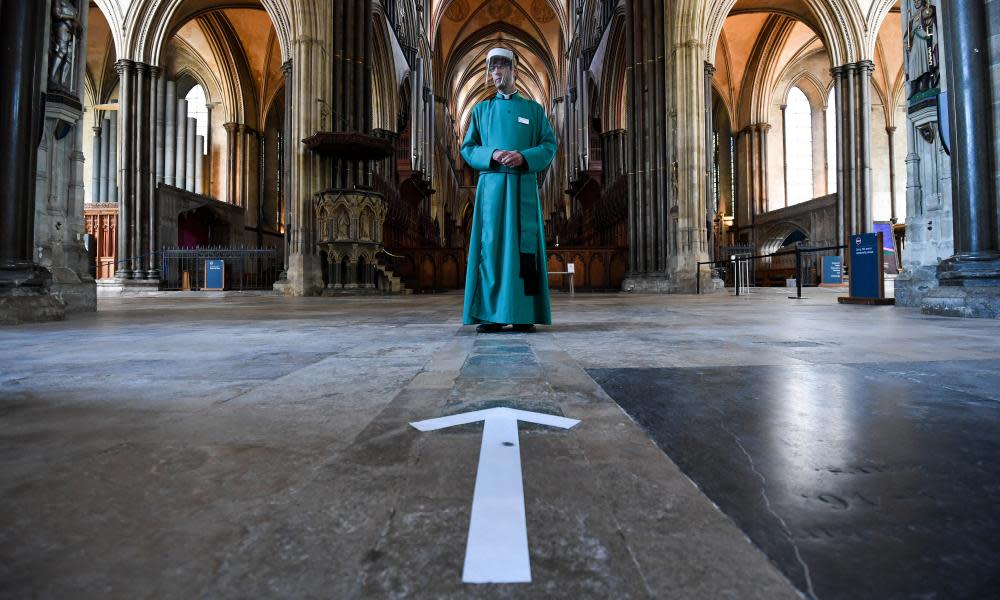Salisbury Cathedral to reopen to tourists with art extravaganza

Visitors are finally returning to one of the UK’s most glorious buildings, Salisbury Cathedral, where they will be met by sights and sounds ranging from a shimmering Antony Gormley figure perched high above the choir to peregrine falcons on the tower.
The cathedral believes that from Wednesday it will be able to welcome 600 visitors a day, well down on the 1,000 or so it would expect to greet on a normal busy summer’s day, but a huge boost for a building that depends on the income tourists bring.
It has put in a range of safety measures including a one-way system that has the bonus of taking visitors past the works yard, where stonemasons can be spotted hammering and chipping away.
Visitors must book online in advance and stay 2 metres apart. The cathedral shop and refectory are not yet ready to be opened but people will be able to enjoy a takeaway on the lawns from the Bell Tower Tea Rooms.
“We can’t wait to welcome visitors back,” said Jane Morgan, the cathedral’s director of communications and development, who is overseeing the plans for reopening. “This building was designed to attract people to it. It just doesn’t feel right when it’s empty. We know people are keen to get back in. Coming to a place like this can feel like arriving in a place of refuge.”
The income that visitors bring in is crucial as it costs £14,000 a day to run the cathedral. Morgan said: “Our visitors are vital to our survival. We receive no regular funding from government in normal times, or from the church, so we have felt their absence greatly in recent months. They play a key role keeping this national treasure going.”
In March, the cathedral was days away from launching an exhibition, its largest contemporary show for almost two decades, to mark the 800th anniversary of the building’s move to its present site when lockdown struck.

Almost four months on, visitors will finally be able to view the exhibition, called Spirit and Endeavour, featuring works by the likes of Gormley, Mark Wallinger, Grayson Perry and Youki Hirakawa carefully installed in nooks and crannies around the cathedral.
The Gormley figure, GRIP (Net) can – just about – be spotted on an arch above the choir. Made out of fine webs of stainless steel, from some angles and in some lights the figure almost vanishes into the building’s fabric.
“For me it, shimmers,” said Jacquiline Creswell, the cathedral’s curator and visual arts adviser. “It feels like a celebration of the people who built this cathedral – strong but also fragile.”
The morning chapel is graced by a 30-minute Hirakawa video showing a candle slowly burning down. “It makes me think of resurrection and renewal,” said Creswell.
Grayson Perry’s tapestry Death of a Working Hero is given a prominent place in the nave. It was inspired by the ceremony of the blessing of trade union banners in another great cathedral, Durham.
A Wallinger video, Threshold to the Kingdom, is projected on to the stonework of the the Trinity Chapel and feel apposite. Filmed covertly, it shows air passengers arriving into a terminal.
Some passengers are greeted and hugged while others walk off out of shot. “It’s so moving, especially in a time when we aren’t allowed to hug people,” Creswell said.
There are more exhibits outside, including a Henry Moore. Look up and the visitor may see the peregrine falcons, which have nested successfully.
But there are vivid reminders that these are not ordinary times. A notice in the north transept asks people to pray for everyone who has suffered because of Covid-19. People are asked to sanitise their hands before lighting a candle.
The Chapter House, home to the 1215 Magna Carta, one of only four in the world, will remain closed for the time being, but a near-perfect facsimile is on display in the main building.
Some curiosities being given prominence for the reopening include the rather gruesome remains of a rat that was found in the skull of William Longespée, the earl of Salisbury, who was present at the laying of the cathedral’s foundations. The rodent has been moved out of the Chapter House and, appropriately, placed beside Longespée’s tomb.


